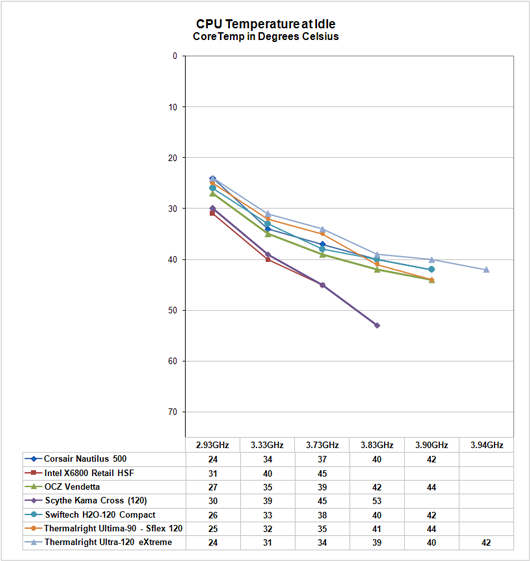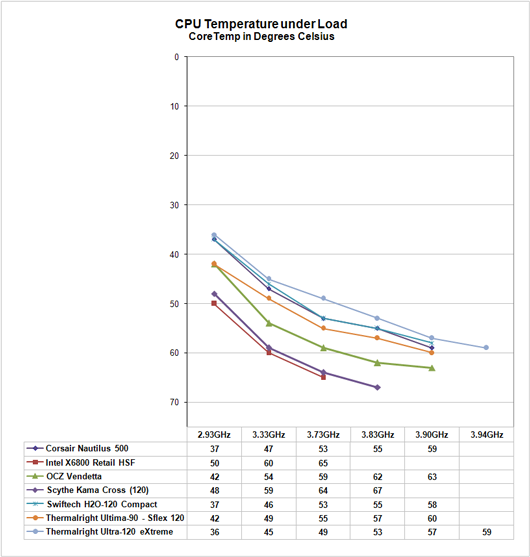New Mid-Priced Coolers from OCZ and Scythe: The Small and the X of It
by Wesley Fink on October 1, 2007 12:05 AM EST- Posted in
- Cases/Cooling/PSUs
Scaling of Cooling Performance
Decent performance at stock speeds is one thing, but we were interested in seeing how both these midrange air coolers scaled in cooling higher overclocks. With the change in test beds and temperature measurement utilities the method of displaying the test results has been changed. The scale is now reversed with zero on top and 75C on the bottom. This means the best performance is now displayed as the highest points in the graph (representing lowest temperature). The reference Intel retail cooler is now at the bottom of the results chart since it exhibits the poorest performance (highest temperatures) of our tested coolers.
The Scythe Kama Cross continues to be a disappointment, even though we tested with the larger and higher output Thermalright S-FLEX 120mm fan. Performance is only 1C better than the Intel retail at most overclocks, though the Kama Cross does reach a higher 3.83GHz compared to 3.73GHz with the retail cooler. Frankly, the smaller stock 100mm fan gave up little in performance to the well-regarded S-FLEX, indicating the fan is not the issue in this design - the heatsink itself appears the limitation.
With the stock 100mm fan performance was within 1C of the 120 fan results across the curve. It was a puzzle at first as to why Scythe equipped the Kama Cross with a 100mm fan when it was clearly designed to work with a 120mm fan. We can only conclude that after developing the cooler, Scythe realized the performance meant the Kama Cross would sell in the midrange and they did whatever was necessary to reduce the Kama Cross cost.
Looking closely at the curves of the top coolers tested, the OCZ Vendetta follows the pattern of the top coolers very closely, with slightly poorer performance across the speed curve. This is exactly what would be expected with a top midrange cooler. The Vendetta does not quite reach the top speed of the best and most expensive, but it comes close. It also scales well.
Cooling efficiency of the OCZ Vendetta and Scythe Kama Cross were then compared under load conditions to the retail HSF and other recently retested CPU coolers. Load testing can be very revealing of a cooler's efficiency. A basically flat line, particularly form 3.73GHz upward, indicates the cooler is still in its best cooling range. A line that is falling rapidly indicates a cooler nearing the end of its ability to cool efficiently. Lines which parallel the best coolers over a range of values are showing similar efficiency slopes.
The Kama Cross closely mirrored the Intel retail cooler. We would prefer a mirroring of the top Thermalright coolers indicating robust cooler scaling. By contrast the OCZ Vendetta, which is both smaller and handicapped by a smaller 92mm fan, mirrored the Ultima-90 and Ultra-120 eXtreme curves. This is very good performance.
As expected of a midrange cooler, the OCZ is warmer across the speed range at load than top coolers. While performance variations are greater, the curve still mirrors the top air coolers and reaches almost as high as the best air and water coolers.
Decent performance at stock speeds is one thing, but we were interested in seeing how both these midrange air coolers scaled in cooling higher overclocks. With the change in test beds and temperature measurement utilities the method of displaying the test results has been changed. The scale is now reversed with zero on top and 75C on the bottom. This means the best performance is now displayed as the highest points in the graph (representing lowest temperature). The reference Intel retail cooler is now at the bottom of the results chart since it exhibits the poorest performance (highest temperatures) of our tested coolers.
 |
| Click to enlarge |
The Scythe Kama Cross continues to be a disappointment, even though we tested with the larger and higher output Thermalright S-FLEX 120mm fan. Performance is only 1C better than the Intel retail at most overclocks, though the Kama Cross does reach a higher 3.83GHz compared to 3.73GHz with the retail cooler. Frankly, the smaller stock 100mm fan gave up little in performance to the well-regarded S-FLEX, indicating the fan is not the issue in this design - the heatsink itself appears the limitation.
With the stock 100mm fan performance was within 1C of the 120 fan results across the curve. It was a puzzle at first as to why Scythe equipped the Kama Cross with a 100mm fan when it was clearly designed to work with a 120mm fan. We can only conclude that after developing the cooler, Scythe realized the performance meant the Kama Cross would sell in the midrange and they did whatever was necessary to reduce the Kama Cross cost.
Looking closely at the curves of the top coolers tested, the OCZ Vendetta follows the pattern of the top coolers very closely, with slightly poorer performance across the speed curve. This is exactly what would be expected with a top midrange cooler. The Vendetta does not quite reach the top speed of the best and most expensive, but it comes close. It also scales well.
Cooling efficiency of the OCZ Vendetta and Scythe Kama Cross were then compared under load conditions to the retail HSF and other recently retested CPU coolers. Load testing can be very revealing of a cooler's efficiency. A basically flat line, particularly form 3.73GHz upward, indicates the cooler is still in its best cooling range. A line that is falling rapidly indicates a cooler nearing the end of its ability to cool efficiently. Lines which parallel the best coolers over a range of values are showing similar efficiency slopes.
 |
| Click to enlarge |
The Kama Cross closely mirrored the Intel retail cooler. We would prefer a mirroring of the top Thermalright coolers indicating robust cooler scaling. By contrast the OCZ Vendetta, which is both smaller and handicapped by a smaller 92mm fan, mirrored the Ultima-90 and Ultra-120 eXtreme curves. This is very good performance.
As expected of a midrange cooler, the OCZ is warmer across the speed range at load than top coolers. While performance variations are greater, the curve still mirrors the top air coolers and reaches almost as high as the best air and water coolers.










22 Comments
View All Comments
rbuffetta - Tuesday, October 2, 2007 - link
Spend the extra $20-30 and get the Thermalright Ultra 120 Extreme. Of all the places to cut corners and save money this is really where it counts to protect your cpu and allow for decent overclocks.EtherealDragon - Tuesday, October 2, 2007 - link
As always, it was a nice read, but why oh why would you plot the 2 graphs on page 7 in that manner? Seems funny to me to have the points on the graphs "drop" as the temperature raises... I guess thats just my .02Wesley Fink - Tuesday, October 2, 2007 - link
It's very easy to change the chart with temp going up if enough readers prefer it. We changed the graph scale after receiving several complaints that the top performance was the lowest chart position on the old charts and difficult to comprehend. If more readers prefer the original chart layout we will be happy to change back. Please let us know.strikeback03 - Tuesday, October 2, 2007 - link
I prefer the old orientation, as it makes sense to me that when you are looking for the cooler with the lowest temperature, you look at the lowest point on the graph.Sentrosi2121 - Tuesday, October 2, 2007 - link
Pretty acceptable for the OCZ cooler. I wonder how it would perform inside an enclosure like the X-Qpack. I'm trying to build a nice gaming rig with the X-Qpack and would like to see if it would fit inside.Basilisk - Tuesday, October 2, 2007 - link
Depends on your skill with a hammer and chisel: The X-Qpack (and X-Qpack2 and Ultra Micro Fly) only have about 75mm of headroom above the CPU -- challenging for a 92mm fam mounted perhaps 40mm above the CPU! Go with a Zalman horizontal flower (7000, 7700, 8700), a few other units or just the stock fan in those cases.
PS: The X-Qpack2 has improved airflow and clearance (length) over the X-Qpack.
Anonymous Freak - Tuesday, October 2, 2007 - link
StorageReview just did a review of the http://www.storagereview.com/1000.sr">Western Digital "Green Power" 1 TB hard drive. While it's not the best performing drive in the world, it's no slouch, and it has the side effect of being the quietest drive they've ever tested. (Plus it runs cool enough that you could probably slap it in aEtherealDragon - Tuesday, October 2, 2007 - link
As always, it was a nice read, but why oh why would you plot the 2 graphs on page 7 in that manner? Seems funny to me to have the points on the graphs "drop" as the temperature raises... I guess thats just my .02Phil Harris - Monday, October 1, 2007 - link
It seems utterly ridiculous to me that these coolers are tested on dual setups.If someone looking to build a quad is trying to find useful information, this review is completely pointless.
A test on a quad however will still provide useful info to someone building a dual core.
The defence that games don't use quads yet is also totally specious, if thats the reason, why bother testing anything other than dual core machines?
Lets all ignore quad core computing until we can play games on them... is that the idea?
This is the second poor quality review in the cases and cooling section within a few weeks, if Anandtech wants to be taken seriously, a serious re-think is required.
Acanthus - Monday, October 1, 2007 - link
Many enthusiasts that are spending money on components for overclocking have opted for cheap quad cores.Sorry to sound frustrated, but this is getting rediculous when we are in the world of $270 quad cores.